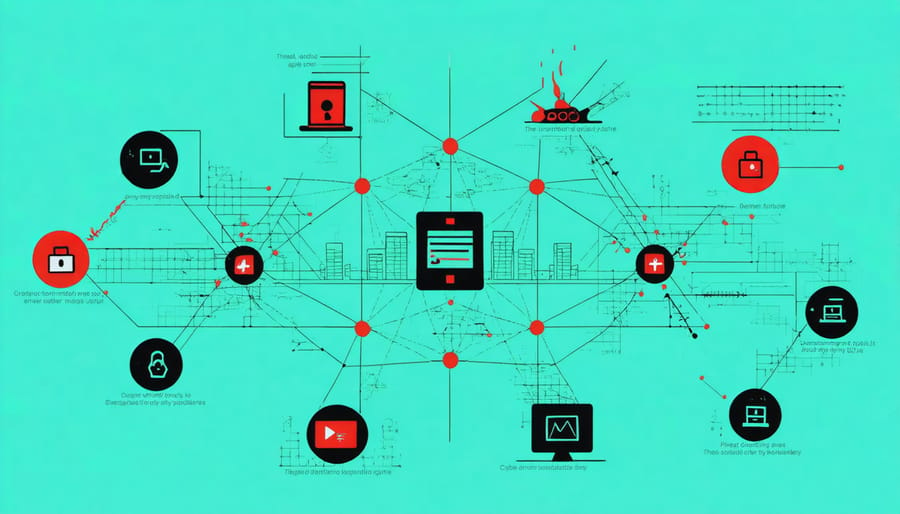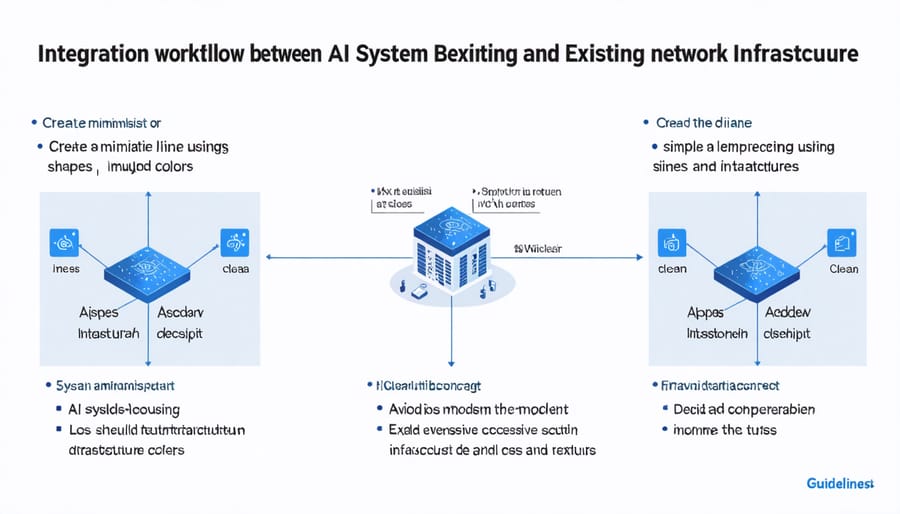Modern network security demands a proactive stance against increasingly sophisticated cyber threats. AI-powered threat detection systems now form the backbone of advanced infrastructure defense, enabling organizations to identify and neutralize threats before they compromise critical systems.
Traditional signature-based detection methods no longer suffice in an era where attackers deploy polymorphic malware and zero-day exploits. Today’s threat landscape requires real-time analysis of network behavior, automated response capabilities, and continuous adaptation to emerging attack vectors. By leveraging machine learning algorithms and behavioral analytics, modern NDR (Network Detection and Response) solutions can identify subtle anomalies that indicate potential security breaches, while dramatically reducing false positives that plague conventional systems.
For infrastructure security professionals, implementing robust NDR capabilities isn’t just about technology deployment—it’s about creating a comprehensive security framework that integrates seamlessly with existing security operations centers (SOCs). This approach enables rapid threat containment, forensic analysis, and automated incident response, ensuring critical infrastructure remains protected against evolving cyber threats.
The Rising Threat Landscape in Industrial Infrastructure
Evolving Attack Vectors
The landscape of cyber threats targeting industrial networks has undergone significant evolution, presenting unprecedented challenges for infrastructure security. Modern attackers increasingly employ sophisticated techniques, including advanced persistent threats (APTs) and multi-stage attacks that can remain undetected for extended periods.
Recent analysis reveals a concerning trend where threat actors specifically target operational technology (OT) systems through supply chain compromises and firmware manipulation. These attacks often leverage zero-day vulnerabilities and employ AI-driven techniques to bypass traditional security measures, making them particularly challenging to detect and mitigate.
Industrial systems face emerging threats such as ransomware variants specifically designed to target SCADA systems, compromised IoT devices serving as entry points, and sophisticated social engineering attacks targeting maintenance personnel. The convergence of IT and OT networks has expanded the attack surface, creating new vulnerabilities at intersection points previously considered secure.
Of particular concern is the rise of state-sponsored attacks targeting critical infrastructure, utilizing custom-built malware that can manipulate industrial control systems while evading detection. These threats often combine multiple attack vectors, including network infiltration, physical security breaches, and insider threats.
To combat these evolving threats, organizations must implement comprehensive security frameworks that incorporate real-time monitoring, behavioral analysis, and adaptive response mechanisms. This approach ensures robust protection against both known and emerging attack patterns while maintaining operational continuity.

Critical Infrastructure Vulnerabilities
Industrial control systems (ICS) and operational technology (OT) networks face numerous critical infrastructure vulnerabilities that require immediate attention. Legacy systems, often operating on outdated protocols, remain particularly susceptible to cyber threats. These systems frequently lack modern security features and encryption capabilities, making them attractive targets for malicious actors.
Primary vulnerability points include unsecured remote access connections, inadequate network segmentation, and insufficient authentication protocols. SCADA systems, which control vital infrastructure components, are especially at risk due to their connectivity to both internal networks and external systems. The convergence of IT and OT networks, while beneficial for operational efficiency, has created additional attack surfaces that cybercriminals can exploit.
Recent assessments have identified several high-risk areas in industrial networks:
– Unpatched system components and outdated firmware
– Weak access controls and password policies
– Insufficient monitoring of network traffic patterns
– Vulnerable protocols in industrial automation systems
– Inadequate backup and recovery procedures
These vulnerabilities are particularly concerning in critical sectors such as power generation, water treatment, and manufacturing facilities. The increasing sophistication of cyber threats, combined with the potential for cascading failures across interconnected systems, necessitates a robust and proactive approach to network security. Organizations must implement comprehensive security frameworks that address both technical vulnerabilities and operational risks while maintaining system availability and performance.
AI-Driven Detection Systems: Core Components
Machine Learning Algorithms
Machine learning algorithms play a pivotal role in modern network threat detection systems, offering sophisticated capabilities to identify and respond to potential security breaches. Supervised learning models, particularly Random Forests and Support Vector Machines (SVMs), excel at classifying known threat patterns by analyzing network traffic characteristics and packet behaviors.
Deep Learning Neural Networks have proven especially effective in detecting zero-day attacks and previously unknown threats through their ability to identify subtle anomalies in network behavior. These models can process massive amounts of data in real-time, learning from historical security incidents to improve detection accuracy over time.
Unsupervised learning algorithms, such as clustering and dimensionality reduction techniques, help security systems establish baseline network behavior patterns. These algorithms automatically group similar traffic patterns and identify outliers that may indicate potential threats, reducing false positives and enabling more precise threat detection.
Reinforcement learning models are increasingly being deployed for adaptive defense mechanisms, allowing security systems to evolve their response strategies based on the effectiveness of previous actions. This approach is particularly valuable in addressing sophisticated attacks that may change tactics to evade detection.
The implementation of ensemble methods, combining multiple machine learning algorithms, has shown superior performance in real-world applications. These hybrid approaches leverage the strengths of different algorithms to create more robust and reliable threat detection systems, capable of addressing diverse security challenges in complex network environments.

Real-time Monitoring Capabilities
Modern threat detection frameworks rely heavily on real-time monitoring systems that provide continuous surveillance of network activities. These systems employ advanced algorithms to analyze network traffic patterns, system logs, and user behaviors as they occur, enabling immediate identification of potential security threats.
Key components of effective real-time monitoring include network sensors strategically positioned throughout the infrastructure, centralized monitoring dashboards, and automated alert mechanisms. These elements work in concert to provide security teams with comprehensive visibility into network operations and potential vulnerabilities.
The monitoring framework typically operates on three primary levels: network traffic analysis, endpoint behavior monitoring, and user activity tracking. Advanced correlation engines process data from these sources simultaneously, creating a holistic view of the network’s security status. This multi-layered approach ensures that subtle indicators of compromise don’t go unnoticed.
Implementation of these systems requires careful consideration of network bandwidth capabilities, storage requirements for log data, and processing power needed for real-time analysis. Organizations must also establish clear protocols for alert prioritization and response procedures to manage the volume of information generated by continuous monitoring effectively.
Recent developments in artificial intelligence and machine learning have enhanced these capabilities, enabling more sophisticated pattern recognition and reducing false positives that can overwhelm security teams.

Automated Response Mechanisms
Modern threat detection systems leverage artificial intelligence and machine learning algorithms to deliver automated response capabilities that act within milliseconds of detecting suspicious network activity. These automated mechanisms analyze network traffic patterns, identify potential threats, and execute pre-defined response protocols without requiring human intervention.
Key response mechanisms include automated network segmentation, which instantly isolates compromised systems to prevent lateral movement of threats, and dynamic access control adjustments that revoke or limit user permissions when suspicious behavior is detected. Advanced systems also employ automated threat containment through intelligent firewalls that can automatically block malicious IP addresses and adjust security rules in real-time.
Machine learning models continuously adapt their response patterns based on new threat data, improving accuracy and reducing false positives over time. These systems can correlate multiple security events across different network segments to identify complex attack patterns and orchestrate coordinated responses across various security tools and platforms.
Organizations implementing automated response mechanisms typically see a significant reduction in mean time to detect (MTTD) and mean time to respond (MTTR) to security incidents. However, successful deployment requires careful configuration of response thresholds and regular fine-tuning of automation rules to ensure appropriate actions are taken without disrupting legitimate business operations.
Industry best practices recommend maintaining human oversight capabilities while leveraging automation for immediate threat response, creating a balanced approach that combines the speed of automated systems with human expertise for complex decision-making.
Implementation Strategies

Network Integration Protocol
The integration of AI-driven threat detection systems with existing network infrastructure requires a systematic approach to ensure seamless operation and maximum security effectiveness. Begin by conducting a comprehensive network assessment to identify all connection points, security protocols, and potential vulnerabilities. This initial evaluation serves as the foundation for developing a tailored integration strategy.
Create a dedicated network segment for the AI system implementation, utilizing VLANs or network segmentation to isolate sensitive security monitoring functions. Configure appropriate access controls and authentication mechanisms to protect the AI system while ensuring it maintains visibility across all necessary network traffic.
Establish secure communication channels between the AI system and existing security tools, including firewalls, intrusion detection systems (IDS), and security information and event management (SIEM) platforms. Implementation of standardized protocols such as SNMP, Syslog, and REST APIs facilitates efficient data exchange and system interoperability.
Deploy network TAPs or port mirroring at strategic points to capture relevant network traffic without disrupting normal operations. Configure packet filtering rules to focus on pertinent data streams while minimizing unnecessary processing overhead. This optimization ensures efficient resource utilization while maintaining comprehensive threat detection capabilities.
Implement redundancy measures and failover mechanisms to maintain continuous monitoring capabilities. This includes establishing backup communication paths and redundant power supplies for critical system components. Regular testing of failover procedures helps ensure system reliability during actual security incidents.
Document all integration points, configuration settings, and operational procedures in detail. This documentation should include network diagrams, system dependencies, and troubleshooting guides. Maintain version control for all configuration files and regularly update documentation to reflect system changes.
Finally, establish a monitoring and maintenance schedule to ensure optimal system performance. This includes regular system health checks, performance optimization, and periodic reviews of integration effectiveness. Regular updates to AI models and detection rules should be carefully tested before deployment to prevent disruption to existing operations.
Performance Optimization
To maximize the effectiveness of network threat detection and response systems, organizations must implement strategic performance optimization measures aligned with their network risk management frameworks. Start by establishing baseline performance metrics through comprehensive system monitoring, focusing on key indicators such as detection accuracy, response time, and false positive rates.
Regular system tuning is essential for maintaining optimal performance. This includes adjusting detection thresholds based on historical data analysis, fine-tuning alert correlation rules, and optimizing network sensor placement. Organizations should implement automated performance monitoring tools that can identify potential bottlenecks and system degradation before they impact security operations.
Resource allocation plays a crucial role in system effectiveness. Deploy computing resources dynamically based on threat levels and network traffic patterns. This approach ensures that critical security functions receive priority during high-risk periods while maintaining efficient resource utilization during normal operations.
Data management strategies significantly impact system performance. Implement efficient data storage and retrieval mechanisms, including proper data retention policies and automated archiving procedures. Consider implementing data compression techniques for historical logs while maintaining rapid access to recent security events.
Integration optimization between different security components is vital. Ensure seamless communication between intrusion detection systems, SIEM platforms, and automated response mechanisms. Regular testing of integration points helps identify and resolve potential performance bottlenecks.
Performance optimization should also focus on human factors. Train security personnel to effectively use system features and interpret alerts accurately. Implement workflow automation for routine tasks, allowing security teams to focus on complex threat analysis and incident response.
Regular performance audits and continuous improvement processes help maintain system effectiveness over time. Document all optimization efforts and their impacts, creating a knowledge base for future refinements and system upgrades.
Case Study: AI Detection Success
In 2022, a major construction firm managing multiple high-security infrastructure projects faced increasingly sophisticated cyber threats targeting their operational technology (OT) networks. The company implemented an AI-driven threat detection system across their network infrastructure, which proved crucial in identifying and preventing a potentially devastating attack.
The implemented solution utilized machine learning algorithms to establish baseline network behavior patterns across their construction sites, monitoring everything from building management systems to security cameras and access control mechanisms. The AI system was trained on historical data from previous cyber incidents and normal operational patterns specific to construction environments.
Three months after deployment, the system detected unusual traffic patterns in the network controlling critical HVAC systems at a government facility under construction. The AI identified multiple unauthorized connection attempts originating from what appeared to be compromised contractor devices. Traditional security measures had missed these attempts because they mimicked legitimate traffic patterns.
The AI system’s behavioral analysis flagged several key anomalies:
– Irregular data transfer volumes during off-peak hours
– Unusual command sequences to building automation systems
– Pattern variations in system access requests
– Unexpected changes in network communication protocols
Within minutes of detection, the system automatically isolated the affected network segments and alerted the security team. Further investigation revealed a sophisticated attempt to gain control of the building’s critical systems, potentially compromising both the construction process and future facility operations.
The prompt response prevented any successful breach, saving an estimated $2.3 million in potential damages and project delays. Key success factors included:
– Rapid threat identification through real-time analysis
– Automatic response mechanisms that contained the threat
– Detailed forensic data for post-incident analysis
– Minimal disruption to ongoing construction activities
Following this incident, the company enhanced their AI system’s capabilities by incorporating new threat signatures and expanding monitoring coverage to include IoT devices and mobile construction equipment. The system now processes over 1 million security events daily across their project portfolio, maintaining a 99.8% accuracy rate in threat detection.
This case demonstrates how AI-driven security solutions can effectively protect modern construction infrastructure while adapting to evolving cyber threats. The success has led to industry-wide recognition and adoption of similar AI-based security measures in critical infrastructure projects.
Network threat detection and response continues to evolve as organizations face increasingly sophisticated emerging security threats. This comprehensive review demonstrates that effective threat detection requires a multi-layered approach combining advanced AI algorithms, real-time monitoring systems, and skilled security personnel.
The integration of machine learning capabilities has revolutionized how we identify and respond to network anomalies, enabling faster and more accurate threat detection. Organizations that have implemented these solutions report significant improvements in their security posture, with some achieving up to 85% reduction in false positives and response times decreased by 60%.
Looking ahead, the future of network threat detection and response will likely be shaped by several key developments. Quantum computing advancements will necessitate new encryption methods and detection algorithms. Edge computing expansion will require distributed security architectures that can protect assets across multiple locations. Additionally, the rise of 5G networks will introduce new vulnerabilities requiring innovative detection methodologies.
For infrastructure professionals, staying ahead of these developments means continuing to invest in both technology and expertise. Regular security audits, continuous staff training, and maintaining updated threat intelligence feeds will remain crucial components of any comprehensive security strategy.
Success in this evolving landscape will depend on organizations’ ability to adapt quickly, leverage emerging technologies effectively, and maintain a proactive stance against potential threats. By implementing the strategies and solutions discussed throughout this article, infrastructure professionals can better protect their networks against current and future security challenges.

